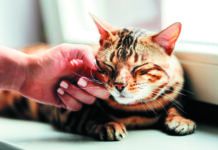To a cat lover, there may be nothing more comforting than a full lap of warm, purring cat — except, perhaps, another one or two nestled nearby. The louder the purr, the deeper the bliss it seems for both person and cat. Purring is the essence of the feline mystique that fascinates us, yet we do not know exactly how and why cats purr. Theories abound — but they remain inconclusive.
It seems simple enough
Purring, by definition, is a continuous vocalization produced during inhalation and exhalation; cats purr with an open or closed mouth at a frequency between 25 and 150 vibrations per second (Hertz, or Hz). In addition to the domestic cat, other cats that purr are the lynx, puma, ocelot and cheetah.
Along with a group of researchers, Robert Eklund, PhD, MA, BA has studied purring in cheetahs and the domestic cat from an acoustic point of view, and the results are intriguing. For example, the egressive (exhalation of air) and ingressive (inhalation) phases were about the same length in the domestic cat whereas the cheetah had longer egressive phases.
Regarding frequency, both cats registered purrs lower than the lowest note of a piano — which is A — and that vibrated at a frequency of 27.5 Hz. (To read more about Eklund’s studies, you can visit www.purring.org.)
Various theories abound
There are numerous theories regarding the mechanism of purring — ranging from impossible to plausible — but nothing with absolutely solid scientific proof.
The vascular theory states the aorta (major heart artery) bends when the cat’s back is arched, forcing blood through that acute bend. Other researchers believe it can be attributed to turbulence in the vena cava (the major vein that carries deoxygenated blood to the heart), not aorta, yet none of the researchers explained why or how cats purr when lying down, with no arched back.
Other theories locate the source in the throat and attribute purring to vibrations or rapid movement of the larynx, flapping of the vocal chords or the vocal chords touching each other, with or without diaphragm involvement causing vibrations.
Then there’s the hyoid bone theory. The hyoid bone, in the throat, supports the tongue and larynx, and whether that bone is ossified (hardened) or semi-flexible causes the ability or inability to purr. This theory states that felids with semi-flexible, elasticized hyoid roar but not purr (lion, tiger, jaguar, leopard and snow leopard) whereas those with completely ossified hyoid purr but cannot roar (domestic cat, cheetah, ocelot, lynx, puma and others).
However, researchers are confounded by the fact that some cats with semi-flexible hyoid can make a “purrish” sound during exhalation. Some researchers believe that it depends on specific vocal folds and elongated tract.
Richard Jakowski, DVM, PhD, DACVP, an associate professor emeritus at Cummings School of Veterinary Medicine at Tufts University, posits a purring theory based on his 40 plus years as a diagnostic pathologist performing thousands of cat autopsies and observing anatomical relationships. As part of these autopsies, he examined the throat region of many cats to investigate what might be vibrating in the airstream to produce a purr sound other than the cat’s vocal cords.
Is it the soft palate?
“A cat has a far longer soft palate than I would have expected for the size of the animal. If you compare a cat’s soft palate with that of a dog of similar size as a cat, the dog’s soft palate is considerably shorter. It’s the dramatically elongated soft palate of cats that is the anatomical basis for my hypothesis for what I think is the actual mechanism of purring,” explains Dr. Jakowski.
“My view is that purring is a result of vibration of the elongated feline soft palate, similar to what occurs in people when they snore. In a colloquial way you could say purring is “musical” snoring. In my opinion, the vocal chords are much too small to make the deep, low frequency sound associated with purring; it’s the vibrating soft palate that produces this sound. The vocal chords are for meowing and the soft palate is responsible for purring,” says Dr. Jakowski.
Purring in kittens
There is no exact answer to why cats purr, but again a variety of theories. We typically think of a purring cat as a happy cat — yet cats purr in many different situations including when in pain or stressful situations, while giving birth and when near death. Purring is also considered to be a form of communication.
“Kittens do not fully develop their hearing until they reach four to five weeks of age; until they are able to hear, non-auditory communication is essential,” says Colleen Currigan, DVM, founder of Cat Hospital of Chicago and president-elect of American Association for Feline Practitioners (AAFP).
“The adult purr is known to consist of a variable voiced region superimposed onto a low fundamental frequency. An interesting study was conducted a few years ago by Dr. H. Campbell with the School of Veterinary Science at the University of Liverpool. It was theorized that vibrations produced by low fundamental frequency could allow “touch” communication between the nursing kitten and the queen while avoiding detection by predators.
“It was also theorized that because kittens are smaller than adults, the low fundamental frequency may be higher in kittens versus adults. The findings revealed that purring in unweaned kittens occurred only in the presence of the nursing mother or the kitten’s littermates. The research also revealed that the low fundamental frequency was higher in newborns and slowly declined as the kittens got older.
“The suggestion, based on this research, is that the function of the purr may change from tactile (sense of touch) communication when nursing to auditory communication after weaning. During that transition, kittens develop, whether learned or instinct, a voiced component into their purr,” explains Dr. Currigan.
Cats turn on the purr box to communicate with humans, too. People who live with cats are familiar with the solicitous purr for our attention, which we obligingly give. According to Elizabeth J. Colleran, DVM, MS, Feline Diplomate ABVP, Tufts graduate and AAFP board member, cats switch on the purr in the presence of familiar humans, when greeting a social feline friend, when feeling drowsy, in response to tactile stimulation such as rubbing and when in a familiar environment. “It all appears to be associated with actual cat-cat or cat-human contact or circumstances under which cat-contact might be desired. Cats learn how much we like it and use it to their advantage. Most people are like Mark Twain, who said ‘I simply can’t resist the cat, especially a purring one’,” says Dr. Colleran.
Cats purr for many reasons and most often we associate purring with a contented cat exhibiting a pleasurable response such as being petted or eating a favorite food — but they also purr while under stress (for example, while recovering from surgery).
Endorphins may play a role
“One thing that always puzzles people is that cats purr when they’re in grave distress such as being in pain or even at a pre-terminal event when they’re dying. The question is, if a cat purrs when it’s happy, why would it also purr when in distress or pain? The answer is that the same neurochemicals — endorphins — are released whether experiencing pain or pleasure,” according to Nicholas Dodman, BVMS, veterinarian and director of the Animal Behavior Clinic at Cummings School of Veterinary Medicine at Tufts University.
When the brain releases feel-good hormones called endorphins — due to either pain or pleasure — the mechanism of purring is activated, says Dr. Dodman. A receptor is activated through a chain of neurological connections and a message sent from a control center down the nerves that supplies the diaphragm and larynx. Purring results.
A therapeutic range
Another unsolved mystery of purring is whether purrs promote bone density and help heal soft tissues, muscles and tendons. What researchers do know is that purr vibrations are in the range between the 25 to 150 Hz and that range is known to be therapeutic for many illnesses and specifically that bones heal best between 25 and 50 Hz.
The concept of biomechanical muscle stimulation (BMS) was developed in the 1970s by Soviet sports scientist, Dr. Vladimir Nazarov, who used it with professional athletes and ballet dancers. Today, BMS is used for quick recovery by elite athletes, physical therapy for weekend warriors and even to treat health conditions such as Parkinson’s Disease. Additionally, this is important to astronauts who spend significant amounts in zero gravity and would experience bone loss if not for BMS.
But does a purring, vibrating cat heal itself? The vets interviewed are skeptical. Dr. Colleran says it is part of the veterinary myth that cats heal faster than dogs after surgery because of purring and self-healing. Dr. Currigan says arthritis in cats is much more common than previously believed. She say that arthritis likely affects about 90 percent of cats over 12 and that it was unnoticed due to the cat’s skill of hiding pain. Do cats self-soothe by purring? Likely, but as we know, it’s unfounded.
The feline purr is calming, comforting, intriguing, complex and scientifically mystifying. Perhaps it should remain the last vestige of the feline mystique. — Ramona Marek, Ms Ed.



